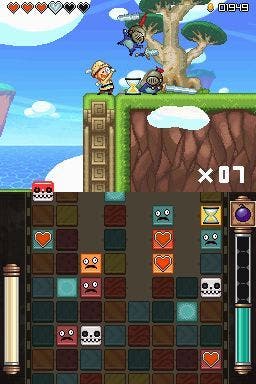Henry Hatsworth in the Puzzling Adventure
Mental blocks.
There is an original idea at the core of Henry Hatsworth in the Puzzling Adventure. This is lucky, as the rest of the ideas in it are less original than putting a a traffic cone on your head and going, "I'm in the Pet Shop Boys."
The original idea is this: what if you combined a puzzle game with a platform game, and created a cause-and-effect relationship between the two? The problem is this: both the puzzle game and the platform game are derivative, repetitive and mediocre. However, the bringing of the two together does create an interesting dynamic.
The platform game is played on the DS's top screen. You play as Henry Hatsworth, who looks like the love child of Dr Snuggles and Willy Fog.
He runs and jumps around 2D environments which are pretty enough, but nothing special (Lava? Ice? Again? Really?).
Hatsworth can swipe at enemies or shoot them, with extra weapons and upgrades available to purchase as the game progresses. Filling up his Super Meter enables him to do special attacks. It also lets him don a robot suit, making him temporarily invulnerable and allowing for yet more special attacks.

The control system, gameplay and level layouts will be familiar if you've ever played Super Mario Bros., Alex Kidd or Wonder Boy. They'll be even more familiar if you've played any of the second-rate clones those games inspired - the platformers that weren't bad, but weren't innovative or interesting enough to make them anything other than forgettable. (Oh Bubsy, where are you now? Dead, hopefully.)
The puzzle game is a match-three affair played on the touch-screen. Using the d-pad or stylus, you switch pairs of coloured blocks around horizontally. When three or more blocks match, they disappear. So once again, it'll be familiar if you've played Zoo Keeper, Puzzle Quest or anything with the word "jewel" in the title.
The twist is you have to keep switching between the two games, and your actions in one affect the other. Each time you kill an enemy in the platform game, for example, it'll show up in the puzzle game as an angry-looking block. If you fail to match the block before it reaches the top of the screen, it reappears at the top of the platformer. Then you have to keep moving out of the way as it repeatedly drops drown and tries to crush you, which is tricky if you're simultaneously facing a load of enemies or a boss.
Each time you collect a power-up in the platform game - extra health, for example - it will also materialise in the puzzle. The power-up will only be activated in the platform game once you've matched it on the screen below. You also need to match the plain blocks to fill up the Super Meter.








